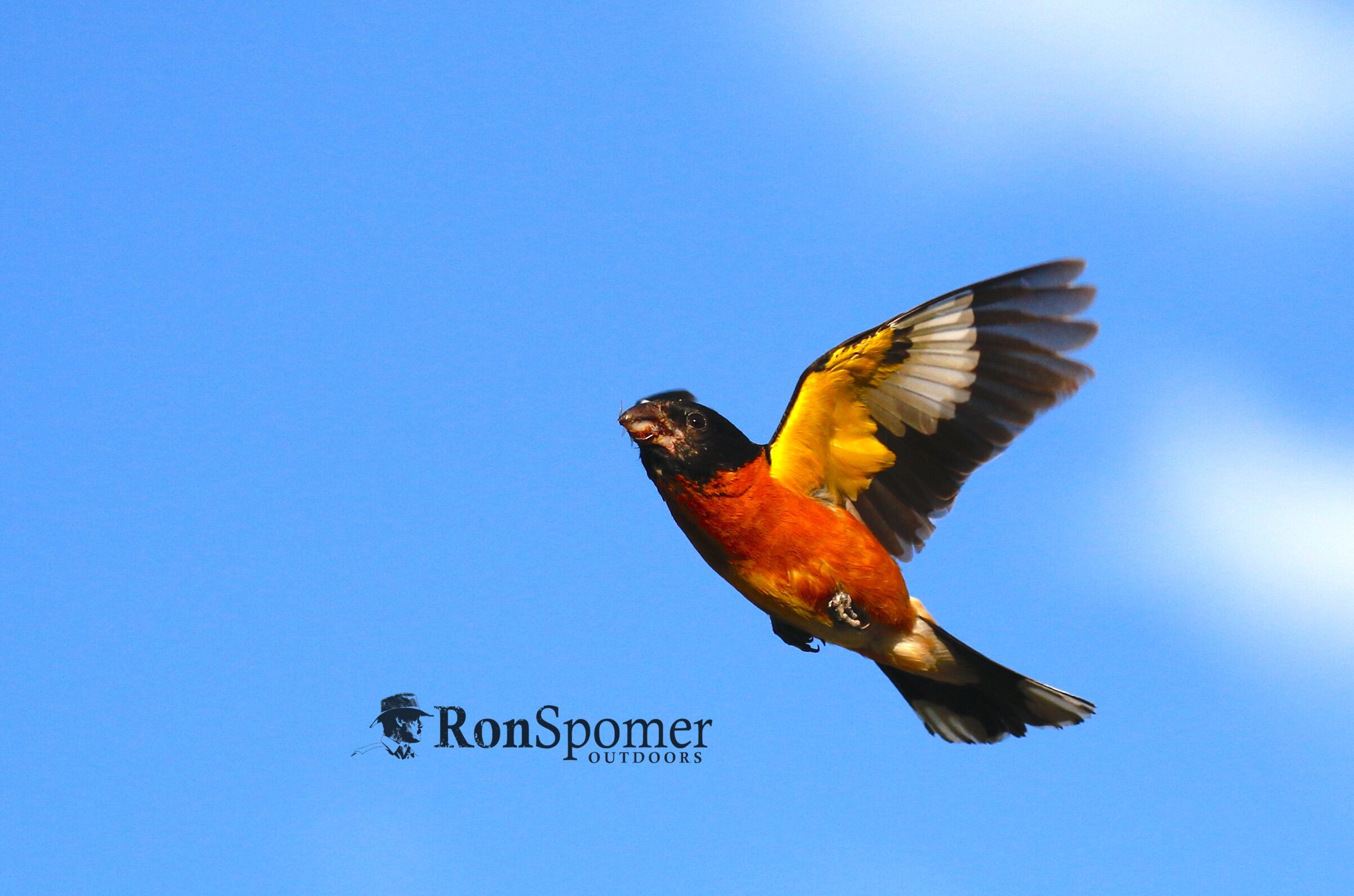Black-Headed Grosbeak Flycatcher!
The hatch was on. The attack was on. The black-headed grosbeak was on.
Songbirds of the most surprising species and variety indulged in a feeding frenzy along our driveway this morning, July 17, 2020. The most surprising of all was the black-headed grosbeak "flycatcher."
An eager and successful participant in the feeding frenzy flies skyward in the hunt for flying ants.
My involvement began at dawn when I saw a Bullock’s oriole feed one of four fledglings in a choke cherry tree just off the deck. I noticed black-headed grosbeaks flitting from limbs like flycatchers hawking insects. Grosbeaks are built for seed eating, so you don't expect them to behave like flycatchers. So, hoping the birds were sufficiently preoccupied with a feeding frenzy that they’d allow close approach, I traded my morning coffee for a Canon 70D and 100-400 IS lens and slipped off the deck to see what was going on.
It proved to be into the most intense fledgling feeding frenzies I’ve ever seen. The center ring was commanded by those fly-catching black-headed grosbeaks.
Flying male black-headed grosbeak taking off.
Fat and getting fatter, this busy male black-headed grosbeak was flying from perches to snap flying ants out of the air. Decidedly unexpected foraging behavior for a relatively slow-moving seed eater.
Several species were snapping flying insects from the sky while others gleaned them from the gravel driveway. The only legitimate flycatchers in the frenzy were several western kingbirds. Other birds included: American robin, gray catbird, cedar waxwing, yellow warbler, black-headed grosbeak, Lazuli bunting, spotted towhee, Bullock’s oriole, pine siskin, and an unidentified sparrow.
Gray catbird on hawthorn branch during fledgling feeding frenzy.
This sleek catbird might have been attracted to the feeding frenzy without actually taking part. I saw it for only a few seconds before it dived back into the hawthorn thicket. It could have been gleaning ants in there.
I was too busy trying to catch birds in flight to concentrate on identifications. Most birds were feeding fledglings, and many fledglings were hunting successfully on their own.
Among this menagerie the grosbeaks were doing the most insect hawking, launching from perches to snatch bugs from the sky. Yellow warblers did the same. Orioles too. Towhees, robins, and buntings seemed to glean most from the ground. Photos explain the rest.
Male lazuli bunting didn't indulge too heavily in the fledgling feeding frenzy.
Too beautiful to flutter with the rest of the crowd, the male lazuli bunting mostly observed from the upper deck.
Most surprising to me were the grosbeaks. Well known seed eaters with large, short beaks, they hardly look equipped to catch flying insects. Yet they proved active, consistent, and successful, both mature birds and juveniles. I concentrated the camera on a mature male in striking plumage.
Flying male black-headed grosbeak on the hunt.
Male black-headed grosbeak wings skyward in hunt for flying insects. Note ant legs on beak.
Closing in. Black-headed grosbeak does his best flycatcher impersonation while closing in on a flying ant. This male fed flycatcher style for at least an hour while I tried to get a sharp photo of the action.
Flying and and black-haeded grosbeak on the attack.
Ant attack. A male black-headed grosbeak maneuvers toward a flying ant on his right. This is a better photo of the ant than the bird. You're looking at the back end of the grosbeak.
The shadow knows. Like a cartoon superhero, this male black-headed grosbeak swoops down on a flying ant.
Black-headed grosbeak male flying with ant in beak.
Black-headed grosbeak wings back to a perch after an aerobatic grab of another flying ant.
Black-headed grosbeak male perched on dead limbs from which he'll fly out flycatcher style.
No rest for the hungry. This male black-headed grosbeak waits on a dead willow limb for his next aerial assault on flying ants. Unexpected behavior for what's considered a rather "plodding" seed eater. Turns out they are not.
American robin with beak stuffed with flying ants. Part of the fledgling feeding frenzy.
With the July ground too dry for earthworms, this robin happily switched to a flying ant diet. It was gleaning them from the gravel driveway while the grosbeaks worked overhead.
This overly stuffed mouthful looks destined for the gullet of a spotted fledgling.
Ron Spomer has been hunting Nature's beauty with cameras since 1972. For these photos he used a Canon 70D and Canon 100-400 IS II lens, handheld.























